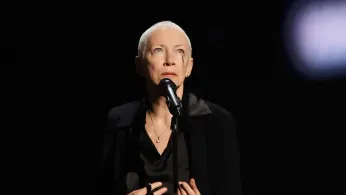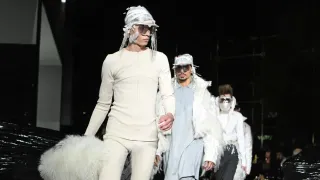
Oct 29
Annie Lennox: The Art of Being Unapologetically Herself
READ TIME: 4 MIN.
Annie Lennox’s story begins in Aberdeen, Scotland, born into what she describes as “scarcity”—not just of material wealth, but of opportunity. “I was born into scarcity…” she reflectsto Attitude Magazine, a phrase that echoes through her life and work, shaping her empathy and drive. Growing up in a working-class family, Lennox learned early the value of resilience and imagination. Music became her escape, her rebellion, and eventually, her vocation. She trained as a classical flautist at London’s Royal Academy of Music, but it was singing that set her free. “Singing gives me an exalted feeling…” she says, describing the transcendent joy she found in using her voice—an instrument she could carry with her anywhere, unshackled by the constraints of her circumstances .
This transition from flute to voice marked the first of many reinventions. In the late 1970s, she co-founded the Eurythmics with Dave Stewart, crafting a sound and image that defied categorization. Their androgynous, avant-garde style—exemplified in the iconic “Sweet Dreams” video—was a deliberate rejection of the hyper-feminine pop star archetype. “I didn’t ever want to be a clothes horse,” Lennox recalls, preferring thrift stores to designer boutiques and creating her own style as an act of independence . Her tightly cropped hair and bold fashion choices were not just aesthetic statements but declarations of autonomy. “Creating my own style and identity gave me a sense of independence and freedom,” she says, a sentiment that resonates with anyone who has ever felt pressure to conform .
Lennox’s career has been a masterclass in nonconformity. She shies away from labels—even “androgynous” makes her bristle—preferring to exist outside binaries. “We don’t need to be afraid of our uniqueness; there are lots of us that are different than the mainstream,” she insists. “It’s a special thing, but the problem is that certainly in the past, we were encouraged to conform to one thing. But people are not binary. We contain elements of opposites, difference. If I say I like pineapple, it doesn’t mean to say I don’t like oranges. Each of us, just like our individual thumbprint, is unique” .
This philosophy extends to her views on sexuality and identity. While flattered by her status as a “gay icon,” Lennox finds the label reductive. “Well it’s not something I set out to do. I mean these labels that are put upon you, like icon, gay icon, they’re sort of forced upon you,” she explains. “It’s certainly not offensive to me, I will take the compliment, but at the same time it’s reductive because I think ultimately we all need to be liberated from these labels that say whether we’re gay or we’re straight, or whatever” . She envisions a future where such distinctions are irrelevant: “I would like to see a world—which is coming much more than it was 20 years ago—where it really doesn’t matter what your orientation is sexually. That’s the planet I live on, it makes no difference to me what a person’s sexual orientation is” .
Lennox’s refusal to be pigeonholed is matched by her commitment to lifting up others. Her activism, particularly through her organization The Circle, focuses on empowering women and girls globally. “I want to use my influence… to push back on such injustice,” she says, channeling her platform into advocacy for gender equality and human rights. Her sense of mission is so strong that it motivates her to stay active and healthy, even joking that she exercises “when I’d much rather be lazy and lie in bed all day eating chocolates” .
Her allyship extends to the transgender community, a group she recognizes has long been marginalized. “As I’m not a trans woman, I can’t know what that lived experience feels like. All I know is that trans people have lived in the shadows, in the darkness, in the margins of life forever and that is very cruel. It’s very unkind. And I would like to see society change, to be more open to differences in people. There is so much more that needs to be done and sometimes it takes something terrible happening for the world to wake up” . Her words are a call to empathy and action, urging society to embrace diversity in all its forms.
Now in her seventies, Lennox has curated her life’s work into a lavish photo-book, "Retrospective," published by Rizzoli. The project is both a personal reckoning and a public celebration. “Doing this book has been part of my journey. It’s been amazing to look back at things that I really never stopped to savour on the way,” she reflects . The images capture not just the glamour of fame but the grit of her origins, the joy of creative freedom, and the depth of her activism.
The book also reveals a more private side of Lennox: her recent ADHD diagnosis, her enduring stage fright, and the simple pleasures of a loving marriage to Dr. Mitch Besser. “It took some time, but I am joyous and freer now to live in a happy, loving relationship,” she shares, a testament to personal growth and contentment .
Annie Lennox’s story is one of constant evolution—from classical prodigy to pop provocateur, from icon to activist, from private individual to public advocate. Her new photo-book is not just a look back but a lens through which to view the ongoing work of her life: empowering others, challenging norms, and using her voice for change.
She remains hopeful for a world less obsessed with labels and more focused on humanity. “There’s a funny evolution that will have to take place, from my perspective, in the so called ‘gay world’ where you don’t even need to say gay or straight anymore because it really doesn’t matter,” she muses . Until then, she’ll keep singing, speaking, and standing up—unapologetically herself, and fiercely committed to a future where everyone else can be, too.






